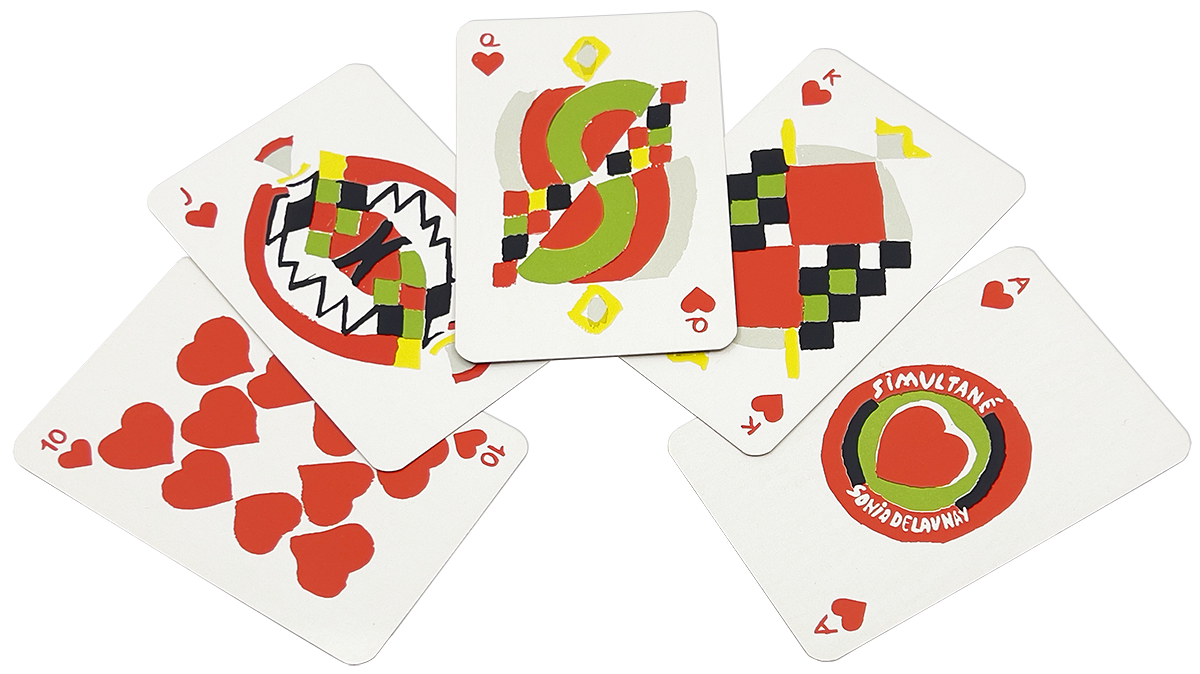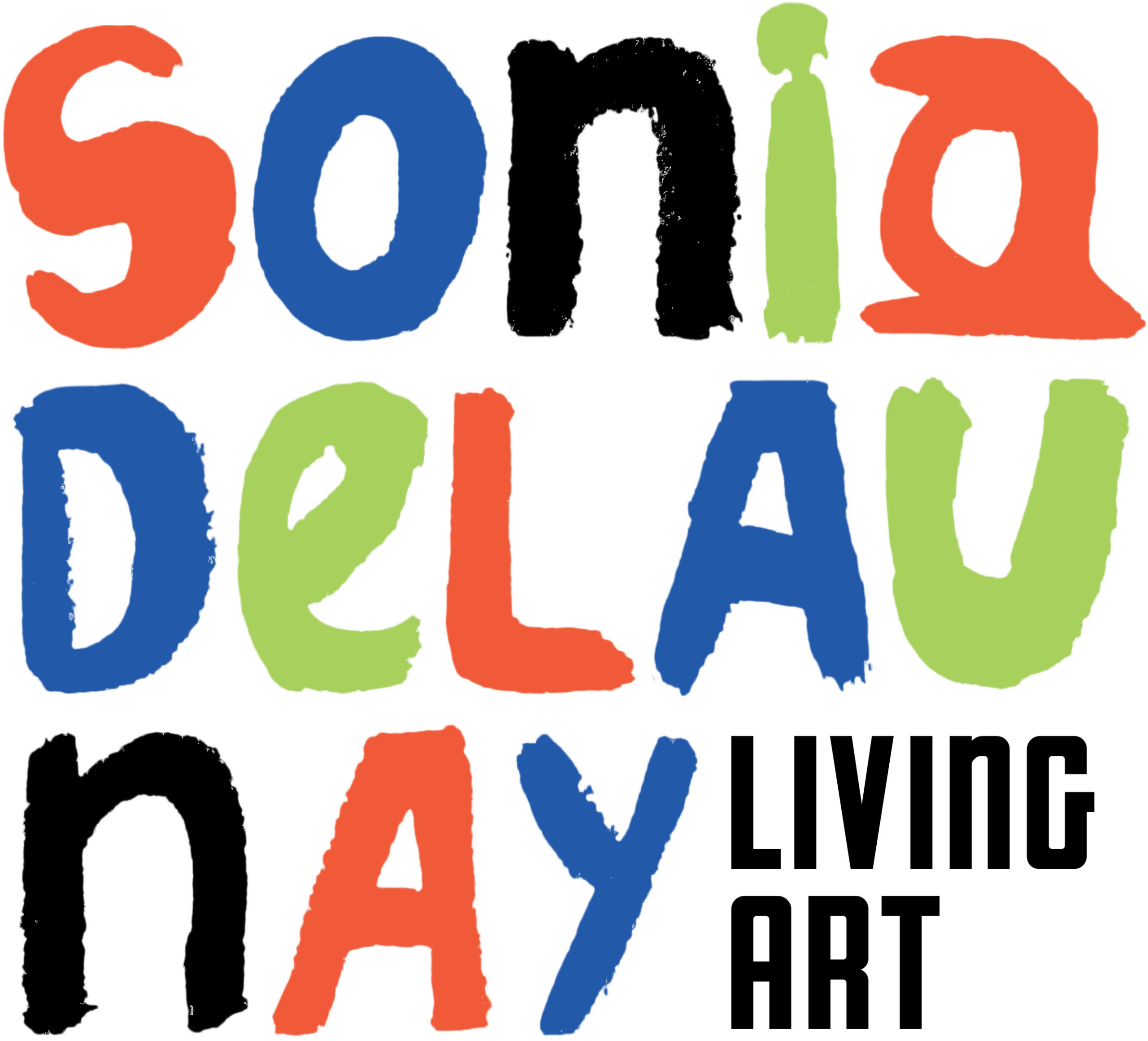A NEW AGE OF SIMULTANISM
Although Sonia Delaunay produced important works in the decade following World War II, it was in the 1960s and 1970s that her art received widespread recognition. French state museums and international galleries honored her with retrospectives and publications while Delaunay continued to experiment with color, light, and optical play in her paintings, tapestries, stained glass, and mosaics. She also found joy in designing less “refined” objects: a paint scheme for the body of a sports car, a record jacket, and playing cards. Delaunay notably returned to her bold patterns from the 1920s, aware that the postwar artistic movements fostered a receptive atmosphere for her earlier avant-garde creations. The relaunch of her monochrome fashions, in particular, signaled that her kinetic patterns predated the Op art movement by decades. Even her “Simultané” branding experienced a comeback: her early fashion plates and costume designs were reissued by publisher Jacques Damase (1930–2014) in elaborate art books and portfolios, while some of her graphic compositions were transformed into a range of textiles, porcelain, and other objects sold commercially by the Artcurial gallery. Delaunay once observed that her art had appeared “forty years too early,” and indeed, the revival of her early works in the 1960s and 1970s proved her right.
A NEW AGE OF SIMULTANISM
Although Sonia Delaunay produced important works in the decade following World War II, it was in the 1960s and 1970s that her art received widespread recognition. French state museums and international galleries honored her with retrospectives and publications while Delaunay continued to experiment with color, light, and optical play in her paintings, tapestries, stained glass, and mosaics. She also found joy in designing less “refined” objects: a paint scheme for the body of a sports car, a record jacket, and playing cards. Delaunay notably returned to her bold patterns from the 1920s, aware that the postwar artistic movements fostered a receptive atmosphere for her earlier avant-garde creations. The relaunch of her monochrome fashions, in particular, signaled that her kinetic patterns predated the Op art movement by decades. Even her “Simultané” branding experienced a comeback: her early fashion plates and costume designs were reissued by publisher Jacques Damase (1930–2014) in elaborate art books and portfolios, while some of her graphic compositions were transformed into a range of textiles, porcelain, and other objects sold commercially by the Artcurial gallery. Delaunay once observed that her art had appeared “forty years too early,” and indeed, the revival of her early works in the 1960s and 1970s proved her right.
Although Sonia Delaunay produced important works in the decade following World War II, it was in the 1960s and 1970s that her art received widespread recognition. French state museums and international galleries honored her with retrospectives and publications while Delaunay continued to experiment with color, light, and optical play in her paintings, tapestries, stained glass, and mosaics. She also found joy in designing less “refined” objects: a paint scheme for the body of a sports car, a record jacket, and playing cards. Delaunay notably returned to her bold patterns from the 1920s, aware that the postwar artistic movements fostered a receptive atmosphere for her earlier avant-garde creations. The relaunch of her monochrome fashions, in particular, signaled that her kinetic patterns predated the Op art movement by decades. Even her “Simultané” branding experienced a comeback: her early fashion plates and costume designs were reissued by publisher Jacques Damase (1930–2014) in elaborate art books and portfolios, while some of her graphic compositions were transformed into a range of textiles, porcelain, and other objects sold commercially by the Artcurial gallery. Delaunay once observed that her art had appeared “forty years too early,” and indeed, the revival of her early works in the 1960s and 1970s proved her right.
Charles Delaunay (1911–1988), Sonia and Robert Delaunay’s son, was a noted jazz promoter. His Vogue label was the preeminent French distributor and producer of music records in the postwar period. Using the shape of a vinyl record as her inspiration, Sonia designed a new logo for the company in the early 1970s.
Charles Delaunay (1911–1988), Sonia and Robert Delaunay’s son, was a noted jazz promoter. His Vogue label was the preeminent French distributor and producer of music records in the postwar period. Using the shape of a vinyl record as her inspiration, Sonia designed a new logo for the company in the early 1970s.
1976
Vinyl record with label and printed cardboard cover after a design by Sonia Delaunay
Private collection
In the last twenty years of her life, Sonia Delaunay created about twenty-four tapestry designs, which were exhibited across France and the United States. In 1972 an exhibition opened at the Musée d’art moderne that featured fourteen works woven by the Manufacture Pinton and two by the Manufacture des Gobelins. A companion exhibition of tapestries was held at the Corcoran Gallery of Art in Washington, DC, at about the same time, introducing American audiences to Delaunay’s approach to abstraction in woven wool.
In the last twenty years of her life, Sonia Delaunay created about twenty-four tapestry designs, which were exhibited across France and the United States. In 1972 an exhibition opened at the Musée d’art moderne that featured fourteen works woven by the Manufacture Pinton and two by the Manufacture des Gobelins. A companion exhibition of tapestries was held at the Corcoran Gallery of Art in Washington, DC, at about the same time, introducing American audiences to Delaunay’s approach to abstraction in woven wool.
1972
Lithograph
Private collection
In 1958 after her retrospective at the Städtisches Kunsthaus, Sonia Delaunay was asked by the Deutsches Spielkartenmuseum (German Playing Card Museum) in Bielefeld to design playing cards in honor of the institution’s tenth anniversary. Conceived as a promotional undertaking, the “Jeu de Cartes Simultané” (Simultané Card Game), was produced in 1964 and became an immediate success. Its initial print run sold out within the year.






Click to explore the card deck
Film (digital screening), 23:41 min., French language dialogue with English subtitles
Collection of Tamar Cohen
In 1958 after her retrospective at the Städtisches Kunsthaus, Sonia Delaunay was asked by the Deutsches Spielkartenmuseum (German Playing Card Museum) in Bielefeld to design playing cards in honor of the institution’s tenth anniversary. Conceived as a promotional undertaking, the “Jeu de Cartes Simultané” (Simultané Card Game), was produced in 1964 and became an immediate success. Its initial print run sold out within the year.
In 1958 after her retrospective at the Städtisches Kunsthaus, Sonia Delaunay was asked by the Deutsches Spielkartenmuseum (German Playing Card Museum) in Bielefeld to design playing cards in honor of the institution’s tenth anniversary. Conceived as a promotional undertaking, the “Jeu de Cartes Simultané” (Simultané Card Game), was produced in 1964 and became an immediate success. Its initial print run sold out within the year.
1964
Printed paper
Private collection






Click to explore the card deck
Film (digital screening), 23:41 min., French language dialogue with English subtitles
Collection of Tamar Cohen
Sonia Delaunay was invited to paint a Matra 530 sports car for the 1967 exhibition Five Cars Personalized by Five Contemporary Artists, a charity event organized by the French magazine Réalités. Matra provided her with technical drawings of the car’s body, which she used to determine the color fields. For Delaunay this project represented yet another intersection of art and modern life, as well as a unique form of promotion.
2023
Plastic model car, fabricated by CHR, France, with custom paint
Private collection
Right:
Drag to rotate car
Film (digital screening), 23:41 min., French language dialogue with English subtitles
Collection of Tamar Cohen
Sonia Delaunay was invited to paint a Matra 530 sports car for the 1967 exhibition Five Cars Personalized by Five Contemporary Artists, a charity event organized by the French magazine Réalités. Matra provided her with technical drawings of the car’s body, which she used to determine the color fields. For Delaunay this project represented yet another intersection of art and modern life, as well as a unique form of promotion.
Sonia Delaunay was invited to paint a Matra 530 sports car for the 1967 exhibition Five Cars Personalized by Five Contemporary Artists, a charity event organized by the French magazine Réalités. Matra provided her with technical drawings of the car’s body, which she used to determine the color fields. For Delaunay this project represented yet another intersection of art and modern life, as well as a unique form of promotion.
Drag to rotate car
2023
Plastic model car, fabricated by CHR, France, with custom paint
Private collection
Film (digital screening), 23:41 min., French language dialogue with English subtitles
Collection of Tamar Cohen
Journals, notebooks, and sketchbooks were part of Sonia Delaunay’s everyday life. She would spend hours jotting down thoughts about art and her surroundings or even philosophical questions, as well as experimenting with compositions for her paintings and other creative endeavors. This particular notebook, which dates to 1967 and has never before been on public view, provides a glimpse of a particularly busy year for her—the year of her retrospective at the Musée national d’art moderne in Paris and, notably, the year that she launched a series of handwoven rugs, some of which are roughly sketched out in its pages. The gouache on display shows a fresh color scheme for Delaunay and is annotated “first yellow in years/ couldn’t use it in a picture/ new color range.”
Journals, notebooks, and sketchbooks were part of Sonia Delaunay’s everyday life. She would spend hours jotting down thoughts about art and her surroundings or even philosophical questions, as well as experimenting with compositions for her paintings and other creative endeavors. This particular notebook, which dates to 1967 and has never before been on public view, provides a glimpse of a particularly busy year for her—the year of her retrospective at the Musée national d’art moderne in Paris and, notably, the year that she launched a series of handwoven rugs, some of which are roughly sketched out in its pages. The gouache on display shows a fresh color scheme for Delaunay and is annotated “first yellow in years/ couldn’t use it in a picture/ new color range.”
1967
Collection of Patrick Raynaud






